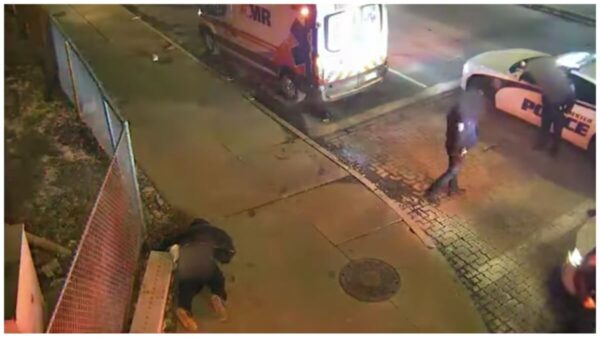Multiple investigations are underway following an incident that took place last November in Rochester, New York, where a man was kicked out of an ambulance, then collapsed on the sidewalk in full view of emergency personnel and police officers, and died a few weeks later.
Rochester Police released bodycam footage of an encounter on Nov. 30, 2023, between paramedics, police, and a man who told them he was having trouble breathing.

In it, police are seen pulling up to an ambulance parked on the street at 2 a.m. that morning. Local news reports say they were called to respond to an assault on board the vehicle.
Bodycam footage shows a female EMT approaching one of the officers saying, “I don’t know what’s wrong with him, but he will not get out of our truck. He’s gotta go.”
She opens up the doors to the truck where the man is inside and the officer tells the man the EMTs want him out of the ambulance. The man replies, “I couldn’t breathe.”
The man is heard heaving and grunting, but the officer commands him to exit the truck, saying, “No games. Get out.”
That same EMT who first approached the officer explained that the man told first responders that he had pain from drinking water, but once he got into the ambulance, he “jumped” at her, “demanding” oxygen, and “would not let go” of her.
The man said he “was freaking out” and told authorities, “You’d freak out, too, if you can’t breathe.” In response, an officer said, “I’d probably try to control myself a little bit better.”
As the man puts on his coat and gathers his belongings, he asks, “Can you take me to the hospital?” to which that same officer immediately says, “No,” and one of the EMTs responds, “We tried to take you, but, honey, that was unacceptable.”
Despite the report that the man allegedly lunged at a paramedic, he wasn’t combative or threatening toward any of the authorities at the scene. He strained to remove himself from the vehicle, but once he got on the sidewalk, he made his way to a bench.
Video taken from a city camera on the street shows the man sit down for a short time, then slide off hunched over on his knees before collapsing completely in full view of police officers and emergency personnel who were still at the scene. The ambulance was still there as well.
However, authorities spent two minutes just pacing around on the street before deciding to respond to his collapse and administer medical assistance. Body camera footage shows officers gathering around the man and a couple saying they noticed blood.
The city of Rochester requested the American Medical Response (AMR), the company that owns the ambulance at the scene, to conduct an investigation.
“We reached out to the family and do not have permission to speak about the details of this incident due to patient privacy laws,” a statement from AMR read. “We viewed the video for the first time yesterday and have launched an internal investigation. We have also requested an investigation by the New York State Department of Health Bureau of EMS and Trauma Systems.”
An internal police investigation is also underway. The Police Accountability Board is also investigating. No officers involved in the incident have been put on leave or disciplined.
Rochester Mayor Malik Evans said last week during a news conference that he was “flabbergasted” because he was only recently informed of what happened. He shared that the man who collapsed passed away mere weeks after the incident, just before Christmas. No other information about his death, including the cause, has been released.
“City residents are people, and they deserve to be treated humanely and with the same attention as anyone else,” Evans said. “We must get to the bottom of this. We must understand how and why this occurred. And we must identify processes and safeguards to ensure that this does not ever happen again.”


